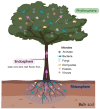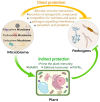Microbiome-Mediated Protection against Pathogens in Woody Plants
- PMID: 38003306
- PMCID: PMC10671361
- DOI: 10.3390/ijms242216118
Microbiome-Mediated Protection against Pathogens in Woody Plants
Abstract
Pathogens, especially invasive species, have caused significant global ecological, economic, and social losses in forests. Plant disease research has traditionally focused on direct interactions between plants and pathogens in an appropriate environment. However, recent research indicates that the microbiome can interact with the plant host and pathogens to modulate plant resistance or pathogen pathogenicity, thereby altering the outcome of plant-pathogen interactions. Thus, this presents new opportunities for studying the microbial management of forest diseases. Compared to parallel studies on human and crop microbiomes, research into the forest tree microbiome and its critical role in forest disease progression has lagged. The rapid development of microbiome sequencing and analysis technologies has resulted in the rapid accumulation of a large body of evidence regarding the association between forest microbiomes and diseases. These data will aid the development of innovative, effective, and environmentally sustainable methods for the microbial management of forest diseases. Herein, we summarize the most recent findings on the dynamic structure and composition of forest tree microbiomes in belowground and aboveground plant tissues (i.e., rhizosphere, endosphere, and phyllosphere), as well as their pleiotropic impact on plant immunity and pathogen pathogenicity, highlighting representative examples of biological control agents used to modulate relevant tree microbiomes. Lastly, we discuss the potential application of forest tree microbiomes in disease control as well as their future prospects and challenges.
Keywords: biological control agents; endosphere; microbiome; pathogen suppression; phyllosphere; plant immunity; rhizosphere; woody plants.
Conflict of interest statement
The authors declare no conflict of interest.
Figures


Similar articles
-
Competition for iron drives phytopathogen control by natural rhizosphere microbiomes.Nat Microbiol. 2020 Aug;5(8):1002-1010. doi: 10.1038/s41564-020-0719-8. Epub 2020 May 11. Nat Microbiol. 2020. PMID: 32393858 Free PMC article.
-
Seasonality and longer-term development generate temporal dynamics in the Populus microbiome.mSystems. 2024 Mar 19;9(3):e0088623. doi: 10.1128/msystems.00886-23. Epub 2024 Feb 29. mSystems. 2024. PMID: 38421171 Free PMC article.
-
How plants recruit their microbiome? New insights into beneficial interactions.J Adv Res. 2022 Sep;40:45-58. doi: 10.1016/j.jare.2021.11.020. Epub 2021 Dec 4. J Adv Res. 2022. PMID: 36100333 Free PMC article. Review.
-
Plant domestication shapes rhizosphere microbiome assembly and metabolic functions.Microbiome. 2023 Mar 31;11(1):70. doi: 10.1186/s40168-023-01513-1. Microbiome. 2023. PMID: 37004105 Free PMC article.
-
A Synthetic Microbial Community of Plant Core Microbiome Can Be a Potential Biocontrol Tool.J Agric Food Chem. 2023 Apr 5;71(13):5030-5041. doi: 10.1021/acs.jafc.2c08017. Epub 2023 Mar 22. J Agric Food Chem. 2023. PMID: 36946724 Review.
Cited by
-
Two transcription factors, AcREM14 and AcC3H1, enhance the resistance of kiwifruit Actinidiachinensis var. chinensis to Pseudomonas syringae pv. actinidiae.Hortic Res. 2023 Nov 20;11(1):uhad242. doi: 10.1093/hr/uhad242. eCollection 2024 Jan. Hortic Res. 2023. PMID: 38222821 Free PMC article.
-
Microbial communities in the phyllosphere and endosphere of Norway spruce under attack by Heterobasidion.Front Microbiol. 2025 Jan 8;15:1489900. doi: 10.3389/fmicb.2024.1489900. eCollection 2024. Front Microbiol. 2025. PMID: 39845034 Free PMC article.
-
Advancing forest pathology: the need for community-driven molecular experimental model systems.New Phytol. 2025 Aug;247(4):1599-1607. doi: 10.1111/nph.70205. Epub 2025 May 11. New Phytol. 2025. PMID: 40350752 Free PMC article. Review.
References
-
- Vettraino A., Morel O., Perlerou C., Robin C., Diamandis S., Vannini A. Occurrence and distribution of Phytophthora species in European chestnut stands, and their association with Ink Disease and crown decline. Eur. J. Plant Pathol. 2005;111:169–180. doi: 10.1007/s10658-004-1882-0. - DOI
Publication types
MeSH terms
Grants and funding
- 2022YFD2201900, 2021YDF22011202/National Key Research and Development Program
- 32122056, 42011045, 31600512/National Natural Science Foundation of China
- CX-21-3045/Jiangsu Agriculture Science and Technology Independent Innovation Fund
- 2021M691605/China Postdoctoral Science Foundation
- 2021K641C/Postdoctoral Science Foundation of Jiangsu Province
LinkOut - more resources
Full Text Sources

